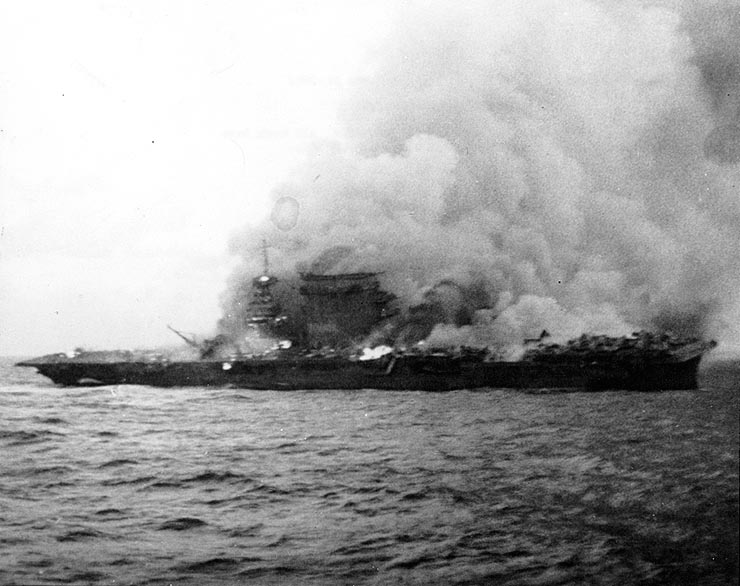ASPI recommends ‘Pacific Crucible: war at sea in the Pacific 1941–42′
Posted By Andrew Davies on November 6, 2014 @ 06:00
 [1]
[1]With ANZUS in the news [2] (PDF) at the moment, this book [3] is a good way to understand where it all started. In early 1942, America needed Australia’s location linking the Pacific and Indian Oceans as a base from which to project power into Southeast Asia. Australia, seriously unprepared for war, needed American combat power. The relationship later formalised as ANZUS was forged then.
I argued recently [4] that our geography makes us a critical partner when American seapower is under challenge in the western Pacific. The degree to which that was true in WWII becomes abundantly clear in Ian Toll’s excellent book. Even before the fall of the Philippines, Singapore, Burma and what was then the Dutch East Indies—most or all were expected to be unable to withstand the Japanese assault—Admiral Ernest King [5], the newly appointed Commander in Chief United States Fleet, identified two critical elements of allied strategy:
King’s mind was clear. The entire Allied strategy in the Pacific depended on two cardinal points: Hawaii must not fall, and Australia must not fall. [He] ordered the new Pacific Fleet chief, Admiral Nimitz, to secure the seaways between Midway, Hawaii and the North American mainland. That was to be his first priority. The second, in only a “small degree less important” was to protect the lifeline between North America and Australia. … By those means the allied war machine would be built up in Australasia…
Two major battles determined that Australia and Hawaii would remain in allied hands. The first was the Battle of the Coral Sea [6]—the first combat between two fleets fought beyond visual range of each other (because of seaborne air power). The transition from battleship to aircraft carrier as the primary weapon of naval warfare is a subtext in this book, and Toll argues (not entirely convincingly) that the fiasco at Pearl Harbour had a silver lining:
Perhaps Mahan would have turned over in his grave to hear it said, but the loss of the American battleships was no catastrophe. It might even have been entered into the ledger as a net gain… As one officer put it, the Japanese converted the American fleet from a “seventeen knot fleet to a twenty-five knot fleet” [and forced] the American high command to acknowledge the ascendency of aviation and submarines.
The Coral Sea clash saw Australia secured as a base for allied operations. While a tactical defeat for the USN, the Japanese abandoned their landings intended to capture Port Moresby, from where its land-based air power could have seriously challenged vital allied sea-lanes. We now know that Japan was overextending itself badly and had no plans to invade Australia [7] but that wasn’t clear at the time (and the Japanese Army was more opposed to the idea than the Navy, which thought it possible).
A month later, the heavy defeat suffered by the Japanese at the Battle of Midway [8] (four fleet carriers lost to one American) similarly secured the western approaches to Hawaii. With Hawaii and Australia safely in allied hands and the Japanese fleet badly depleted of air power, the defeat of Japan became almost inevitable.
Both battles are described in convincing detail, and what’s striking is the role played by chance. In carrier-on-carrier battles, which side gets the first strike in matters a lot—once a force starts losing flight decks from which to launch counterattacks, it’s hard to regain the initiative. In both battles the Americans got in first, striking a significant (but not decisive) blow in the Coral Sea, and essentially crippling Japan’s naval power-projection capabilities in a single action at Midway by disabling three carriers by airstrikes (all later sunk), followed by a fourth later.
The more experienced Japanese aviators were much more able than the Americans to coordinate their formations and timings. But at the Coral Sea, the Japanese aircraft were launched on the first—but incorrect—reported sighting of the American carrier group. At Midway, perhaps because of that experience, they were held back after the first—but correct—report. In both cases they were out of position when it mattered most and the American planes got in first. At Midway, American good fortune was compounded when poorly-coordinated flight-paths nonetheless saw multiple attacks arrive from different directions and, crucially, different heights at the same time.
There’s much more to this book (not least the importance of American codebreaking efforts). The weighty first section—which the Wall Street Journal didn’t like [9]—describes the pre-war period, showing that a conflict between American and Japanese interests in the western Pacific was foreseeable as early as the turn of the century, and made even more likely by the political rise of the Japanese military in the 1920s. For anyone not sure about this history, it’s a good place to start. (Though if you’ve read about these events before, you might [10] or might not [11] be enthused about another serve.)
Andrew Davies [12] is senior analyst for defence capability and director of research at ASPI. Image courtesy of the Wikipedia [13].
Article printed from The Strategist: https://www.aspistrategist.org.au
URL to article: https://www.aspistrategist.org.au/aspi-recommends-pacific-crucible-war-at-sea-in-the-pacific-1941-42/
URLs in this post:
[1] Image: http://www.aspistrategist.org.au/wp-content/uploads/2014/11/USS_Lexington_brennt.jpg
[2] ANZUS in the news: http://www.uts.edu.au/sites/default/files/18924-acri-anzus-booklet-web.pdf
[3] this book: http://books.wwnorton.com/books/Pacific-Crucible/
[4] argued recently: http://www.aspistrategist.org.au/northern-australia-how-much-defence-is-enough/
[5] Admiral Ernest King: http://en.wikipedia.org/wiki/Ernest_King
[6] Battle of the Coral Sea: https://www.navy.gov.au/history/feature-histories/battle-coral-sea
[7] had no plans to invade Australia: http://www.aspistrategist.org.au/aspi-recommends-australia-1942-in-the-shadow-of-war/
[8] Battle of Midway: http://www.history.navy.mil/Midway/Battle-of-Midway-Overview.html
[9] Wall Street Journal didn’t like: http://online.wsj.com/articles/SB10001424052970204190704577024143531507710
[10] might: http://www.navyhistory.org/2012/11/book-review-pacific-crucible-war-at-sea-in-the-pacific-1941-1942/
[11] might not: http://www.nytimes.com/2011/11/27/books/review/pacific-crucible-war-at-sea-in-the-pacific-1941-1942-by-ian-w-toll-book-review.html?pagewanted=all&module=Search&mabReward=relbias%3Aw%2C%7b%221%22%3A%22RI%3A9%22%7d
[12] Andrew Davies: https://www.aspi.org.au/about-aspi/aspi-staff/senior-analysts/andrew-davies
[13] Wikipedia: http://en.wikipedia.org/wiki/File:USS_Lexington_brennt.jpg
Click here to print.